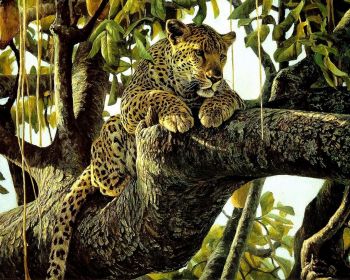Difference between revisions of "Leopard"
Tao alexis (talk | contribs) |
|||
| Line 5: | Line 5: | ||
| noapp = 1–2 | | noapp = 1–2 | ||
| behaviour = presocial | | behaviour = presocial | ||
| − | | range = alpine, desert, jungle, rainforest, savanna, steppe, veldt, woodland | + | | range = [[Alpine (range)|alpine]], [[Desert (range)|desert]], [[Jungle (range)|jungle]],<br>[[Rainforest (range)|rainforest]], [[Savanna (range)|savanna]], [[Steppe (range)|steppe]], [[Veldt (range)|veldt]], [[Woodland (range)|woodland]] |
| size = 28 in. at the shoulder | | size = 28 in. at the shoulder | ||
| weight = 190 lbs. | | weight = 190 lbs. | ||
| Line 16: | Line 16: | ||
| attack = claw/claw, bite | | attack = claw/claw, bite | ||
| dmg = 1–4/1–4, 2–8 | | dmg = 1–4/1–4, 2–8 | ||
| − | | special = rake, surprise on a 1–3, surprised only on a 1 | + | | special = [[Raking (attack)|rake]], [[Surprise (combat)|surprise]] on a 1–3, surprised only on a 1 |
}} | }} | ||
| − | + | ||
| + | The '''leopard''' | ||
| + | |||
| + | Spotted lions, or cave lions, are an exceptionally large spotted variety of the more familiar lion. They should be treated a rare, though they have a wide range stretching from central and east Africa to the Asiatic steppes. Extremely rarely, they may be found in the decidious forests of Eastern Europe. | ||
| + | |||
| + | |||
| + | The male of the species is not differented from the female, as are lions. They have a longer, narrower muzzle, and have a grayish flaxen colour, with striations that are earthly brown. They typically give birth to 1-2 cubs; once the mating period has completed, the male remains with the female until birth, hunting and storing food. When the cubs are born, the male will remain solitary until rejoined by the female after the cubs have become old enough to fend for themselves. Thus, if a solitary spotted lion is encountered, it will almost always be a male; if two, it will probably be a male-female pairing, and if three, it will be a female with her two cubs. | ||
| + | |||
| + | The spotted lion attacks with their jaws and forepaws. If the spotted lion strikes with both forepaws, it will then get two additional attacks, raking with the rear claws, each causing 2-8 damage. | ||
| + | |||
| + | The spotted lion is very observant in its habitat and cannot be easily startled. It is therefore only surprised on a 1 in 6. | ||
| + | |||
| + | |||
| + | See BestiaryThese carnivores live in tropical woodlands and jungles. They hunt by laying in wait and leaping upon their prey, surprising on a 1–3. Leopards can spring 20 ft. upwards or ahead 25 ft. If they scare hits with both forepaws during a melee round, the leopard gains 2 additional attacks that round, each attack at 1–4 hit points damage. | ||
Revision as of 01:08, 24 August 2020
| Species | feline |
| No. Appearing | 1–2 |
| Behaviour | presocial |
| Range | alpine, desert, jungle, rainforest, savanna, steppe, veldt, woodland |
| Size | 28 in. at the shoulder |
| Weight | 190 lbs. |
| Intelligence | 3 |
| Armour Class | 6 |
| Hit Dice | 3+2 |
| Action Points | 6 |
| Max. Stride | {{{stride}}} |
| THAC0 | 18 |
| Hp/Die | d8 |
| Attack Forms | claw/claw, bite |
| Damage | 1–4/1–4, 2–8 |
| Special Attacks | rake, surprise on a 1–3, surprised only on a 1 |
The leopard
Spotted lions, or cave lions, are an exceptionally large spotted variety of the more familiar lion. They should be treated a rare, though they have a wide range stretching from central and east Africa to the Asiatic steppes. Extremely rarely, they may be found in the decidious forests of Eastern Europe.
The male of the species is not differented from the female, as are lions. They have a longer, narrower muzzle, and have a grayish flaxen colour, with striations that are earthly brown. They typically give birth to 1-2 cubs; once the mating period has completed, the male remains with the female until birth, hunting and storing food. When the cubs are born, the male will remain solitary until rejoined by the female after the cubs have become old enough to fend for themselves. Thus, if a solitary spotted lion is encountered, it will almost always be a male; if two, it will probably be a male-female pairing, and if three, it will be a female with her two cubs.
The spotted lion attacks with their jaws and forepaws. If the spotted lion strikes with both forepaws, it will then get two additional attacks, raking with the rear claws, each causing 2-8 damage.
The spotted lion is very observant in its habitat and cannot be easily startled. It is therefore only surprised on a 1 in 6.
See BestiaryThese carnivores live in tropical woodlands and jungles. They hunt by laying in wait and leaping upon their prey, surprising on a 1–3. Leopards can spring 20 ft. upwards or ahead 25 ft. If they scare hits with both forepaws during a melee round, the leopard gains 2 additional attacks that round, each attack at 1–4 hit points damage.
See Bestiary
